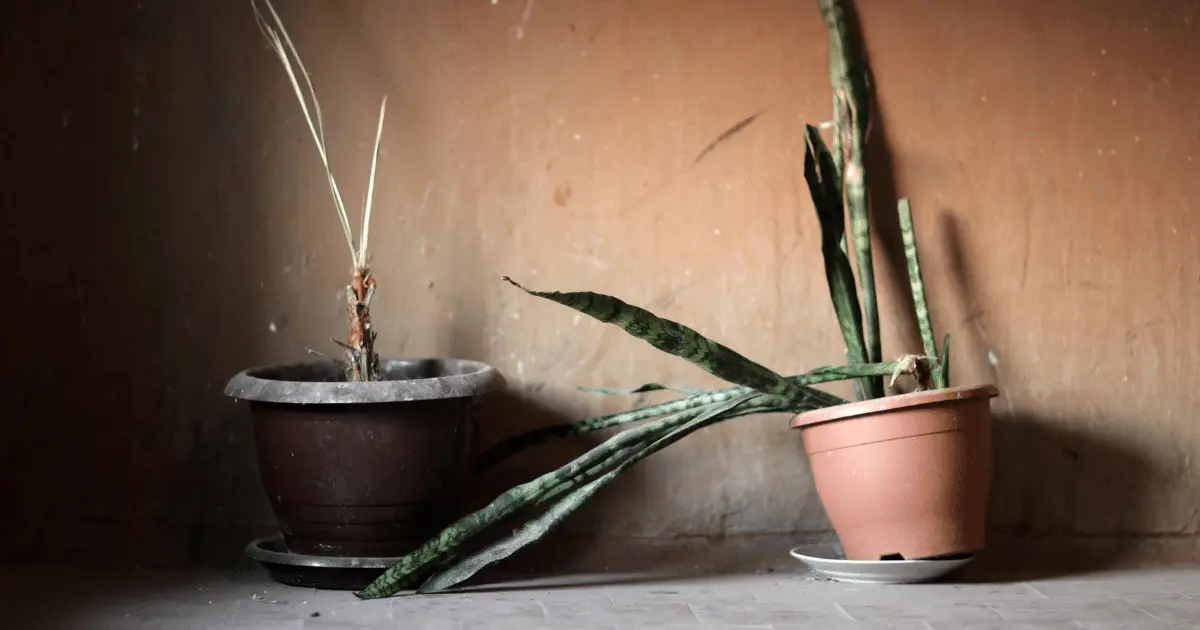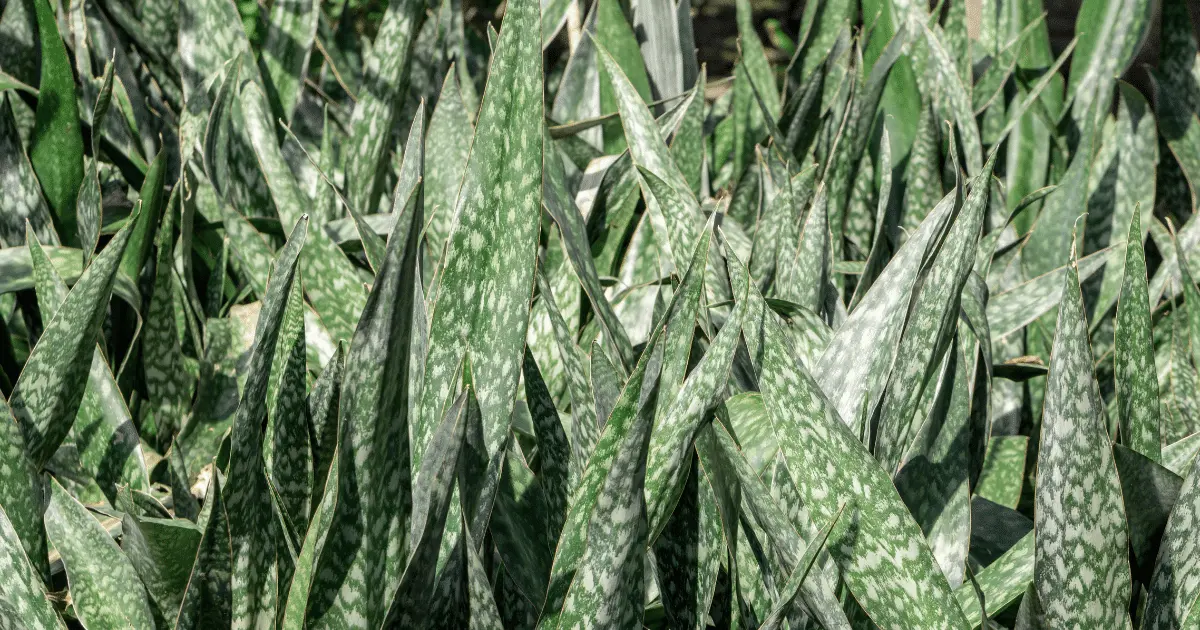The Snake Plant, also known as Dracaena trifasciata (formerly Sansevieria trifasciata), is a durable indoor plant that can endure nearly most settings. They are similar to succulents in that they do not require much water and can survive in most environments except in extreme cold.
They’re also one of the simplest plants to cultivate indoors, making them ideal for beginners. The Snake plant is also popular among gardeners and plant enthusiasts. It has sharply pointed leaves that resemble snakeskin. Even the hardiest plants can experience problems from time to time.
There could be several reasons why a Snake plant appears unhealthy or dies, but don’t worry; almost every plant problem has a solution.
How Can I Revive My Dying Snake Plant?

Brown, dry leaves, root rotting, wet bottom leaves, and leaf spots show that a snake plant is dying. Another cause could be yellowing, drooping, or wilting leaves in snake plants, a common problem that, if not addressed, can lead to snake plants dying prematurely. To resurrect a dying snake plant, water it frequently, change the pot, and relocate it to a light-filled area where it can grow.
Here are some common snake plant problems and the solutions for each.
1. Wood Rot
Root rot refers to a group of fungal diseases that attack plant roots. Snake plant roots become mushy and discolored, and the leaves wilt when infected with root rot. Wet soils are more prone to root rot. As a result, root rot is frequently caused by poorly draining potting soil and overwatering.
You should examine the roots if you suspect your plant has root rot. Remove your plant from the container and dust off any excess potting soil. Your plant is infected if you notice brown, red, or soft roots.
The good news is that you can save a snake plant infected with root rot. The first step is to cut away all infected roots. After that, re-pot your plant in a well-draining soil mix, watering only when the top few inches of soil are dry.
2. Temperature Change
Snake plant prefers warm climates and is native to Africa, where hot climates exist. It is also the birthplace of many succulents. With high humidity in the winter, your plant’s leaves may become damaged, and its cell walls may break from within.
This causes a blockage in the flow of nutrients, allowing the green color to be more green and the plant to be healthier. It also obstructs the water path, resulting in moisture loss at the top and wilting leaves.
Symptoms include mushy leaves, scars on the leaves, yellowing, wilting, and other symptoms that occur when plants are not adequately watered for several days.
Trim the damaged leaves and relocate your snake plant to a healthy low to mid-humid temperature zone, which may aid recovery. You can also remove half of the infected leaves.
Change the location and provide them with warm covering in the winter if it is cold there. Also, don’t prune too much; only remove infected leaves.
3. White Spots on Leaves

White spots on your snake plant’s leaves are a sign of a fungal infestation. Powdery mildew, a fungal disease, is the most common cause of white spots on succulents. The fungus might kill the plant by causing a white powder to accumulate on the leaves.
If you notice white spots on your snake plant, you should treat it with a fungicide.
Use neem or lavender oil to eliminate powdery mildew on succulents, but don’t go overboard! Use only one drop on each affected leaf and repeat the process in two weeks if necessary. If your plant has a lot of white spots, you may need to apply this treatment several times. It would help if you also tried removing dead or dying leaves and cleaning them with a damp cloth.
4. Poor Drainage
Even if you water your snake plant regularly, wet soils can result from poor drainage.
Regarding drainage, two factors should be considered: the soil mix and the container. These two components collaborate to allow excess water to escape.
Snake plants prefer a potting mix that is well-draining and aerated. Houseplant soil mixes frequently hold more water than snake plant soil.
To improve drainage, add more perlite to a peat-based potting mix. Alternatively, you can use a succulent-specific well-draining soil mix.
Re-pot your snake plant in a well-draining mix if you suspect it is growing in a poorly-draining combination. But before you re-pot, ensure your plant’s container is in good condition!
Excess water should be able to escape through drainage holes in the pot if it doesn’t, re-pot your snake plant into a new hole-punched container.
5. Red Leaves Spots
Drechslera erythrospila, a fungal infection, is the culprit for the red leaf spots on snake plant leaves. This problem occurs during the summer or spring when there is a hot sun above the head and the temperature is warm, but it can also occur during other seasons.
Symptoms of this type of problem include red spots or slight dotted redness in the leaf and tan at the center.
The only thing that applies here is pruning the leaf, which will only stop the spread, but for heavy infestations, you can also use a copper or sulfur-based fungicide. If removing the leaves does not work, you can try chemical treatment to prevent other spores.
Snake plant leaves should not have water on them for an extended period; they should go inside the soil, avoiding any standing water. If your plants have been left outside for a while, check them for infection before bringing them inside.
6. Soft/ Mushy Roots
If your snake plant’s roots are mushy and soft, they have probably rotted. Rotting roots are typically caused by overwatering, but pests or diseases can also cause them.
When the roots become soft and mushy, remove the plant from its container and trim away the rotten roots. The plant should then bere-potted in fresh soil and not watered for a week. After a week, you can begin to water the plant lightly and gradually increase the amount of water. Before watering your snake plant again, make sure the potting soil is completely dry.
It would help if you also looked for other signs of disease or pests on the plant. If you carefully water it, your snake plant will grow more vital than ever!
7. Lack of Water
While snake plants do not require a lot of water, they can become thirsty! This is especially true when they are growing well in brighter areas.
Your snake plant may begin to droop if you do not provide enough water and the soil remains dry for more than a few weeks.
Fortunately, the solution is simple: increase the frequency with which you water! When the top three to four inches of soil on your snake plant are dry, water it.
The ideal watering schedule will be determined by factors such as temperature, time of year, and sun exposure. You should water your snake plant once every two to four weeks.
While your plant will not perk up immediately after watering, you should notice a difference within a week. If you don’t, another problem is most likely causing the drooping.
Takeaways
- Overwatering and damp soils are common causes of a dying snake plant, causing the leaves to turn yellow or brown and droop. Temperatures below 50°F can cause cold stress and lead to the death of a snake plant.
- Curling leaves can indicate cold stress if exposed to freezing or drought stress because the leaves store water.
- Brown spots on the leaves frequently indicate sunburn. Snake plants prefer bright indirect light and will develop brown spots if exposed to direct sunlight.
- To resurrect a dying snake plant, replicate the conditions of its native range by providing infrequent watering, indirect light, and keeping the temperature warm to avoid cold stress. If the snake plant is dying, take leaf cuttings from healthy tissue to propagate it.
- Also, try to determine your plant’s needs and tend to them accordingly. It is not until there is an obvious problem with your plant then you start to figure out ways to fix it.
Snake plants are incredibly resilient and easy to care for, but they, too, have limits. If your snake plant exhibits any of the above symptoms, it is time to intervene. Fortunately, most treatments for reviving succulents are simple. If the leaves on your snake plant are drooping, the first step is determining the cause.
Once you’ve determined why your plant’s leaves aren’t looking so good, take the necessary steps to correct the situation. Snake plants can last for 20 years or more under ideal growing conditions. If you still need to figure out why your plant’s leaves are drooping, give it the best care and environment possible. Your snake plant should recover in time.
